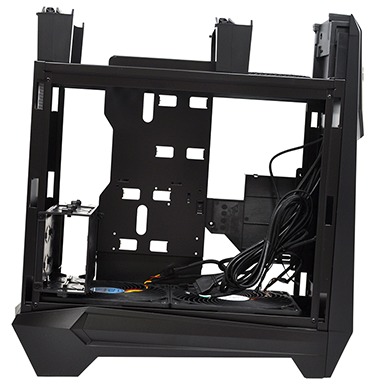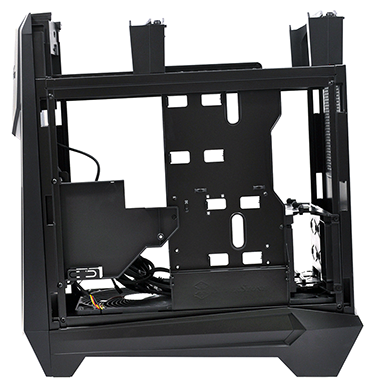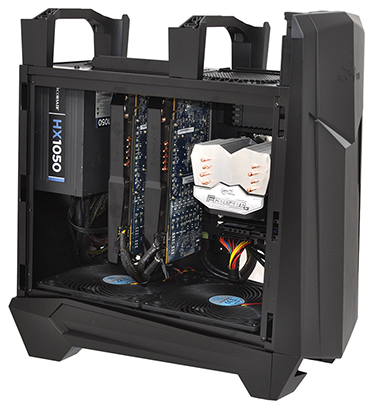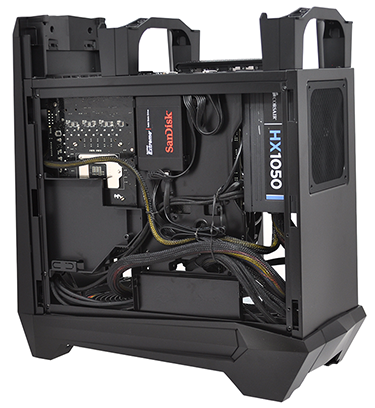Inside the Raven RV05
It's the top of the case, unusually, where most of the action takes place. We can see the PSU bay, seven secured expansion slots, as well as a spare 120mm fan mount. Note the two carry handles as they do come in handy when building into the case, as well as the various holes that run through them - these are in place to ensure all screws are accessible with a long-handled driver.
Elsewhere, we can see a pair of switches tucked behind the front panel that are available to toggle the speed of the two pre-installed fans between low (600rpm), medium (900rpm) and high (1,200rpm). On top of this column is a minimalist I/O panel that has two USB 3.0 ports and audio and microphone jacks flanked by power and reset buttons on either side. Both buttons provide good feedback via an audible click, but we aren't keen on the rubber flap that covers the USB ports - it comes away completely and is just asking to be lost.
Stepping inside reveals a build space that's noticeably smaller than any previous Raven. There's no traditional storage column to speak of, with SilverStone choosing to focus on what it deems to be the essential performance parts.
So what do we have? Well, there's support for the standard Micro-ATX and ATX motherboard form factors, but if you really wanted to, you could actually squeeze a larger SSI-CEB board in here. Whichever you choose, the motherboard is fastened to a wide central column and a thin column near the front panel, leaving a void for access to the rear of the CPU mount. Remember, the motherboard is rotated by 90 degrees, so that the I/O ports face upward.
Support for 5.25in bays may be nonexistent, but SilverStone does have a few other storage tricks up the Raven RV05's sleeves. A slit along the right-front edge points to a slim, slot-loading optical drive bay that's positioned just behind the motherboard, so you won't need to rely on external disc-media solutions, and there's room for up to four other storage devices, too.
Up to two SSDs can be mounted to the rear of the motherboard tray, and both of these bays have screws that attach to the sides of 2.5in drives, meaning SSDs can be added/removed after motherboard installation without any issues. Then, in the bottom left corner, there's a removable cage that can house up to two 3.5in hard disks.
Last but not least, bottom-to-top airflow is provided by a duo of pre-installed 180mm Air Penetrator fans installed at the base of the chassis. The RV05 sits high enough off the ground to ensure sufficient airflow, and a pull-out dust filter will help keeping both fans running optimally over time.
On the whole, the internal layout is logical (for a 90-degree orientation, at least) and SilverStone has done well in trimming the Raven down to size. However, the space-saving does come with an obvious drawback: the RV05 isn't as easy to build into as most other mid-tower solutions. Whereas most cases allow you to simply bung-in high-end hardware, building with the RV05 requires a bit of planning, thought and consideration.
Here are some possible complications you'll need to take into account. Firstly, the PSU bay works better with smaller units. Our HX1050 does fit in, but we had to remove the 3.5in drive cage that would normally sit below it in order to get easier access to PSU cables. Secondly, cable management isn't easy. There isn't a great deal of room behind the motherboard, so cables have to be routed a little more neatly than usual. We found that it helps to install the PSU first and route power cables prior to the motherboard going in, but even then, cable management proved tricky.
In the end, we found ourselves covering up one of the two 2.5in SSD mounts with excess cabling, and having already removed the 3.5in drive cage, this doesn't leave a lot of room for storage devices. Using a Micro-ATX motherboard might free up a little more space, but whichever you approach the build, you should be able to achieve a relatively-clean final look after a bit of trial and error. We're quite pleased with our end product, and with the 3.5in drive cage removed, there's hardly anything obstructing the two bottom fans.
We like the fact that a magnetic dust filter is provided to cover the PSU vent, and we appreciate the extra-long, sleeved, front-panel connectors, but the RV05 is clearly geared toward a specific array of components. A short PSU would be recommended, a high-capacity SSD would be preferred over hard disks, while CPU height and GPU length is limited to 162mm and 312mm, respectively.
And what about liquid cooling? Well, the RV05 is designed primarily as an air-cooled enclosure, but radiator-mounting opportunities do exist. There's a spare 120mm mount up top that's ideal for an all-in-one CPU cooler, and the bottom two fans can be removed to reveal a choice of 2x180mm, 2x140mm or 3x120mm mounts.
The new Raven isn't as easy-going as a more traditional mid-tower solution, but with a little effort it can be used to put together for a very powerful build. Now let's find out if the stack-effect cooling is as effective as it's made out to be.













